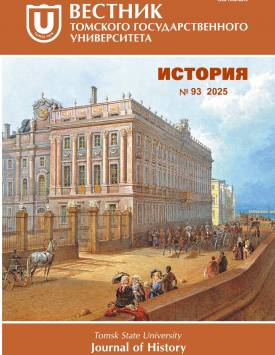The district police officer of Siberia in 1867–1917: a collective portrait on the example of the Kuznetsk and Mariinsky counties
The police chief was a very influential official. He was considered the head of the county and headed not only police structures, but he also was in charge of the medical and educational departments, and participated in the work of many public and collegiate institutions. The purpose of our study is to compile a collective portrait of the district police officer of Siberia on the example of the heads of the Kuznetsk and Mariinsky district police departments. To achieve this goal, biographical information was collected about all police officers who served in these counties. The data was collected for a total of 39 staff members. The compilation of a collective portrait was carried out using prosopographic methods based on the following parameters: a person's background, level of education, age and rank at the time of taking office, previous position, duration of service as a police officer, and further fate. As a result of the study, it was found that for most of the officials, the appointment to the post of police officer was a promotion (67%). For a significant part of officials, this position was the last in their career (38%). When police officers moved to a new place of service, more than half of them (54%) ended up in an equivalent position. This meant they had no career advancement. In rare cases, there was a demotion or transition to the civil service. A collective portrait based on the above parameters looks like this. By origin, the police officer could equally be either from the nobles of the European part of Russia, or from the Siberian chief officers' children of officials. He received his education in the provincial gymnasium or in the district school in the European or Siberian provinces. Most often he had a secondary or incomplete secondary education. He entered the post of police officer at the age of about 41, while having the rank of titular adviser. Before being appointed to a position, he, as a rule, served in another county or even in another province. He was a district police officer for only about 2.5 years. Most often, the post of police officer was the pinnacle of his career, since after it he either continued to serve in a comparable or similar position in another county (province), or retired. The author declares no conflicts of interests.
Keywords
county police officer, Siberia, police, group portraitAuthors
| Name | Organization | |
| Ermolaev Alexey N. | The Federal Research Center of Coal and Coal-Chemistry of Siberian Branch of the Russian Academy of Sciences; Kemerovo State University | al-ermolaev@yandex.ru |
References

The district police officer of Siberia in 1867–1917: a collective portrait on the example of the Kuznetsk and Mariinsky counties | Tomsk State University Journal of History. 2025. № 93. DOI: 10.17223/19988613/93/5
